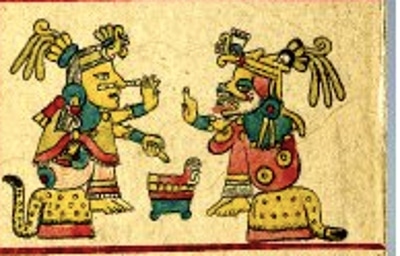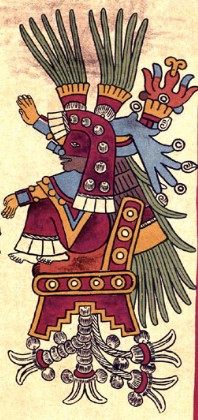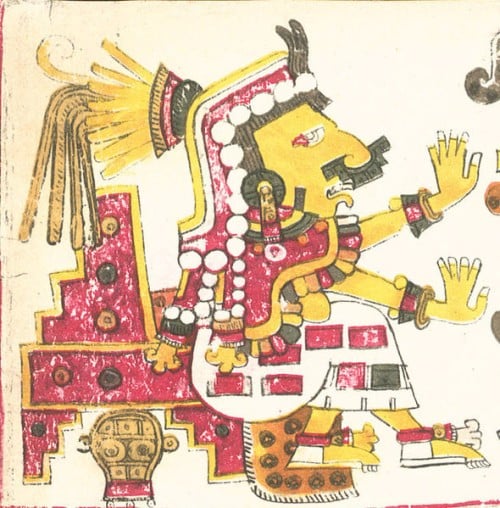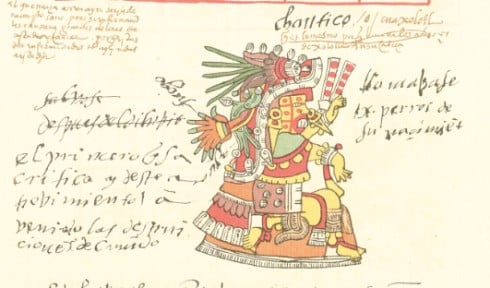When we talk about fire, we often talk about its dangers. The expression “playing with fire” shows how much we fear it. However, fire also keeps us warm and lights up even the darkest nights. It makes no wonder that the hearth and fire were often symbols for the entire household.
The Aztec goddess Chantico ruled over the hearth and fire, which made her the goddess of the home, family, and household. So many times, we focus on more “exciting” deities that fight wars or seduce their numerous lovers, but household deities can be just as interesting. Chantico is a prime example of that, and if you want to learn more about her, keep reading!
Chantico’s Origins

Chantico isn’t as “popular” and well-known as some other Aztec deities, so there aren’t many myths about her. Some of her myths probably got lost over the past few centuries. However, the several Chantico stories that we do know about tell us a lot about this goddess.
Paprika and Punishment
Tonacatecuhtli was a fertility god who practically ruled over Aztec food sources. With that power, this god would sometimes declare fasting times, during which Aztecs couldn’t eat certain foods, and sometimes, they had to abstain from eating anything at all.
In one such instance, Tonacatecuhtli ordered another fast, during which he allowed no one to eat paprika. However, Chantico loved paprika too much to abstain from using it. She prepared roasted fish and decided to season it with some paprika.
Tonacatecuhtli was furious with Chantico because he saw this as an act of disrespect. So, he decided to punish her by turning her into a dog. Since then, she has also been known as Chicunaui itzcuintli, which means “Nine Dog.”
The Role of Chantico

Apart from gaining infamy by breaking the fast, Chantico was famous for her close connection to the home, fire, and paprika. These three things might look completely random and like there is nothing connecting them, but that’s not true.
For example, we already mentioned the connection between the fire and the home/household. In ancient times, the hearth was a place where families lit fires to cook their food and stay warm during cold winter months. As such, they considered the hearths to be sacred because they literally kept them alive.
The hearth symbolism is present in almost every culture and religion, including the Aztecs. Chantico ruled over the fire and hearth, and she was the one who made the home and kept it running smoothly.
However, fire could always become uncontrollable, and such was the case with Chantico. Those who would anger her would soon regret it. She was a precious ally and a good protector but a dangerous enemy.
Just like fire, no one could truly tame Chantico. Her story of breaking fast is a perfect example of that. Even though Tonacatecuhtli was a powerful god, much more powerful than her, she still disobeyed his orders and did what she wanted to do.
Her connection to paprika isn’t surprising. Ripe paprikas are red, similar to the fire. But the similarities between paprikas and fire go deeper than just the appearance. Paprikas come in several varieties, whose flavors can range from mild to extremely hot, just like fire.
The Symbolism of Dog Transformation
When I first heard about Chantico’s story and how she transformed into a dog, I wondered why. Why the dog, and why not some other animal? Then, I started thinking about the symbolism of dogs and their role in Aztec society.
First of all, the whole concept of being transformed into an animal as a punishment was very popular in the Aztec religion. Chantico wasn’t the only Aztec deity that transformed into an animal, and the power of shapeshifting was common for Aztec gods.
By transforming into a certain animal, either voluntarily or as a punishment, gods would take on certain characteristics of that animal, and we don’t think of physical features only. For example, Aztecs considered dogs to be guardians and protectors, especially for the dead souls that needed to cross into the Underworld.
On the other hand, Chantico was a goddess of hearth and fire, and as such, she already had the role of protecting the home and family. So, her transformation into a dog only solidified her role as a protector and guardian.
She didn’t just protect the homes and families. She also protected the Aztec armies. Aztecs invoked this goddess when they needed protection from the advancing Hernan Cortes and his conquistador forces.
Red Butterfly
Another interesting aspect of Chantico is that stonecutters from the town of Xochimilco called her Tlappapalo (red butterfly) and Papaloxaual (butterfly painting). Apart from symbolizing the transformation (remember Chantico getting transformed into a dog?), for Aztecs, butterflies also symbolized the souls of the dead.
This is a second association of this goddess with the souls of the dead. I already mentioned that Aztecs believed that dogs were protecting and guiding the souls of the dead. Chantico, as the “red butterfly” and the “nine dog,” has strong ties to the souls of the dead and the Underworld.
So, this goddess and her role were much more complex than it may seem at first glance. Yes, she was a wild and untamed goddess of fire who paid a price for her disobedience. However, she was also a goddess of hearth, home, and military, and she served as a protector and guardian to both the living and the dead.
The Depiction and Appearance
Since she was the goddess of fire, Aztecs used a lot of red and yellow to depict Chantico. Nowadays, we can see her in several codices (pictorial Aztec manuscripts portraying various deities and their associated myths).
Visual Depiction in Codices
For example, in Codex Borgia, Chantico has yellow skin on both her face and her body, with two red streaks on her face. This depiction draws some parallels between her and Xolotl, the Aztec god of fire. Where she has red streaks on her face, Xolotl has black markings. This similarity shouldn’t be surprising since both are fire deities.

Apart from the coloring of her face, we can also notice that Chantico is sitting on a chair under which there is a flask. When it comes to jewelry and accessories, Chantico has a nose ornament and a disc-covered wrap around her head.
In Codex Borgia, there is also another drawing that portrays her symbols – an eagle foot covered with jaguar skin, sitting on a sacrificial blood dish. This drawing symbolizes the association between this goddess and warfare.

In Codex Rios, this goddess is wearing a military-style headdress made of poisonous cactus spikes. On her head, there is also a crest made of green warrior’s feathers, which further connects her to her military role.
In other depictions, Chantico wore obsidian sandals. Obsidian is a natural glass forming around volcanoes, so it is a natural choice of material for a fire goddess.
Written Depiction
Bernardino de Sahagun was a Franciscan friar who lived among Aztecs during the Spanish conquest. He spent 50 years studying their language, religion, and traditions, and he also described Chantico. He described her as having lips made of rubber bulge, with half of her face painted red.
In this depiction, Chantico wore gold earrings and a bouquet of dried herbs. Her shirt was made of water flowers, and her shield was made of eagle feathers. One of her hands ends in a tip made of inverted feathers, covered with obsidian paint. Her belt, sandals, and kilt were white.
Chantico Rituals and Festivals
Sahagun also described the way that Aztecs worshipped Chantico. They worshipped her in temples known as tetlanman. During the ritual, the priests prepared her feast. For that, they needed red and black pigments, small marine snails, sandals, and a robe.
Montezuma, a famous Aztec emperor, used an idol effigy of Chantico during the battle. This effigy had a removable leg, which Montezuma would take and use to hit against the ground. Montezuma used this to curse Spanish invaders and protect the Aztec empire.
Of course, since she was the goddess of fire, her priests would also light ritual fires as a way of invoking and appeasing her.
Chantico’s Relationship With Other Aztec Goddesses
As soon as I read that Aztecs also called Chantico a “red butterfly,” I immediately thought of Ītzpāpālōtl, the “obsidian butterfly” goddess. While Ītzpāpālōtl had a more prominent connection to the dead souls, Chantico also had some connections to the world of the dead, as I explained above.
Additionally, some scholars claim that Chantico is just a manifestation of the goddess Coyolxāuhqui, the Aztec goddess of the moon and the Milky Way. They base this theory on the giant head found in the Templo Mayor.
This head, also known as the Coyolxauhqui-Chantico monument, has symbols of both goddesses. For example, it has obsidian sandals – a clear symbol of Chantico, but it also features symbols of Coyolxauhqui, so there isn’t a clear consensus of which goddess this head should belong to.
When it comes to other Aztec goddesses, we have no knowledge of any connection between them and Chantico. However, since our knowledge relies solely on manuscripts that survived up until today, it is safe to assume that all Aztec goddesses had some sort of connection and interaction.
Chantico and Other Religions
Unlike many other Aztec goddesses, this goddess is similar to goddesses from other religions and cultures. Many cultures had female deities that protected the home, hearth, and fire. For example, the Greek goddess Hestia is one of them.
Hestia (and her Roman equivalent, Vesta) is a goddess of home and hearth, just like Chantico. Celtic goddess Brigid was the goddess of fire, forge, hearth, and healing.
Christianity
In general, Aztec goddesses, even though powerful and fascinating, can still be terrifying, with some of them being bloodthirsty and violent. As such, it is hard to draw a parallel between them and Christian female saints, who were praised for their meekness and obedience.
However, there is one Christian saint similar to Chantico – Saint Brigid of Kildare. Many scholars and historians claim that Saint Brigid was simply a Christianized version of the Celtic goddess Brigid.
In any case, Saint Brigid is a patron saint of Ireland, and she was an abbess who founded the abbey of Kildare in the 5th century. In her honor, the monks of this monastery have tended a perpetual fire up until the 12th century, when this monastery was destroyed.
Because of her connection to the home, hearth, and perpetual fire, Saint Brigid is probably the closest to Chantico.
Chantico’s Legacy
Even though Chantico was a minor Aztec deity and we don’t know much about her, what we know was enough to learn some spiritual lessons. The first lesson comes from the nature of fire. What provides us warmth and comfort can also hurt and destroy us.

Additionally, we shouldn’t fear the change, even if it is painful and unwanted. Even such changes can help us find our purpose in this life. Oftentimes, we wander through life, wondering why we are even here. Then, something disrupts us and changes us forever, but it also gives our life meaning.
Don’t be afraid to embrace your inner fire. Keep it burning inside you, but try not to burn yourself. Don’t resist the change, accept it as necessary and learn how to grow from it.
Chantico Symbols
Many gods and goddesses have certain symbols that can help you channel them. By wearing these symbols, devotees feel closer to their chosen deities. If you want to come closer to Chantico and channel her fire, you should look for these symbols:
General
Since Chantico is the goddess of fire, everything fire-like is a good choice for a symbol. Fire itself, hearth, candles, torches, and even volcanoes are all great choices for Chantico symbols.
Obsidian is another good symbol for this goddess because it is “born” from fire, and many artistic depictions show her wearing obsidian sandals, which is another nod to her fiery nature.
Animals
According to the legend, Tonacatecuhtli turned Chantico into a dog after she disobeyed him and broke the fast. That’s why dogs are great symbols for this goddess. They are protective, just like she is. However, she could learn a thing or two about obedience from these animals!
Another animal that can be a good symbol is a butterfly. Chantico’s other names refer to butterflies, and butterflies symbolize the transformation as well as the dead souls, just like Chantico.
Some other animal symbols of this goddess are eagle, jaguar, and snake.
Plants
Paprika, both as a vegetable and as a spice, is the best symbol of Chantico. After all, her story revolves around eating paprika. This goddess loved paprika so much that she was willing to accept a punishment for eating it. Paprika is red and hot, just like fire, just like Chantico.
When she was offering protection to the Aztec warriors, Chantico wore a headdress made of poisonous cactus spikes. That’s why the cactus plant is another great choice for her plant symbol.
Perfumes/Scents
Spicy and fiery scent notes, such as pepper, cinnamon, jasmine, citrus, cloves, and cardamom.
Gems and Metals
Sometimes, Chantico wore golden earrings and other jewelry, which is why this precious metal is such a great choice as her symbol. Just like fire, gold has a certain warmth, and as such, it symbolizes Chantico.
Colors
Yellow and red are the colors of Chantico’s face and body, as well as the colors of fire. As such, they are good symbols for this goddess. Some other good color choices are black, gray, and white.
Meditations to Invoke the Goddess Chantico
- Chantico, keep my inner fire alive, and don’t let it fizzle out.
- Give me comfort and protection when I need it, oh mighty goddess.
- Help me transform into a better version of myself.
- Allow me to find my purpose in life, and help me fulfill that purpose.
- Teach me the difference between the rules I should follow and the rules I should break.
Want to Bring More Chantico Qualities in Your Life?
- This might sound like a cliche, but keep your inner fire alive. Find something you are passionate about, and don’t let that passion die. It can be a hobby, work, or anything else that you hold dear.
- Eat spicy foods. They are tasty and great for your metabolism and blood circulation. Of course, don’t overdo it, as you don’t want to cause stomach issues.
- If you have a fireplace, light it, at least in winter. If you don’t have it, you can light candles or invest in a good lamp with warm light. This will bring a certain warmth to your home and make it comfier for everyone living in it.
Featured Image Credit: Unknown author, Public domain, via Wikimedia Commons

